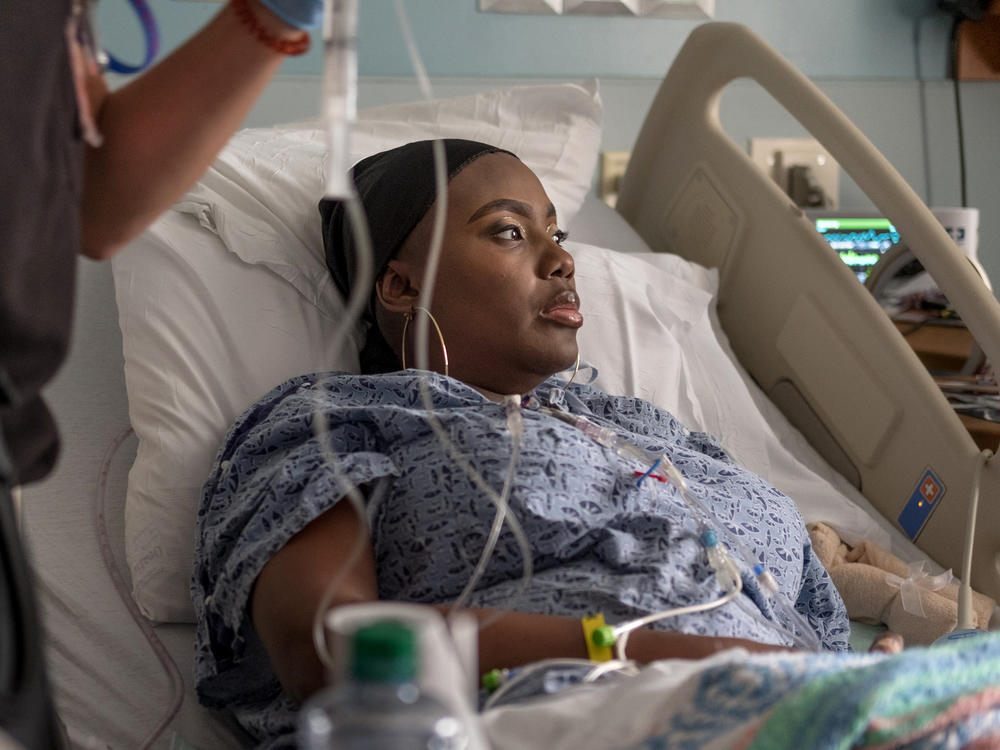Section Branding
Header Content
Sickle cell patient's journey leads to landmark approval of gene-editing treatment
Primary Content
Four years ago, Victoria Gray was lying in a hospital bed, exhausted by a lifetime with sickle cell disease and recovering from a grueling experimental treatment she hoped would save her.
Today, the Forest, Miss., mother of four is brimming with energy and hope. She's working full time, keeping up with her teenage children and traveling the world with her husband.
Gray's transformation is the result of the landmark medical experiment that she launched and which culminated in December with a milestone: The Food and Drug Administration's approved the first treatment that uses gene-editing to alleviate a human illness. It's the first genetic therapy for the brutal blood disorder, which had long been neglected by medicine.
For the past four years, NPR has been chronicling Gray's story. NPR broke the news when Gray became the first patient to get the treatment and had exclusive access to report on her ensuing experience.
"I'm ecstatic," Gray told NPR about the Dec. 8 approval. "It's a blessing that they approved this therapy. It's a new beginning for people with sickle cell disease."
A medical marvel that may be out of reach
While the treatment has turned Gray and other patients' lives around, many hurdles remain. The therapy is expensive — $2.2 million per patient — and is complicated and arduous, raising questions about whether it will be accessible to the patients who need it most. Sickle cell disproportionately affects people of African descent and is most common in less affluent countries.
Other questions remain as well: Will the treatment keep working? Will it extend patients' lifespans? Will it cause unforeseen complications in the future?
"This is something that we've been waiting for more than 70 years," said Dr. Lewis Hsu at the University of Illinois Chicago, who serves as the chief medical officer of the Sickle Cell Association of American. "But there are many issues ahead of us."
At the same time, the approval is generating excitement because other treatments that use the gene-editing technique CRISPR are showing promise for other diseases, ranging from rare but devastating genetic disorders, such as muscular dystrophy, to common ailments, including cancer and heart disease.
"It's only the beginning," said Jennifer Doudna of the University of California, Berkeley, who shared a Nobel Prize for helping discover CRISPR. CRISPR allows scientists to make very precise changes in DNA much more easily than ever before. "It's an amazing time," she told NPR.
A grueling treatment for a brutal disease
When NPR introduced Gray to listeners and readers in July 2019, she was 34 and had just undergone the gene-editing procedure at the Sarah Cannon Research Institute in Nashville, Tenn. It was uncharted territory, spurring high hopes but also fraught with uncertainty and risk. It was the first time cells that had been edited with CRISPR had been infused into a patient with sickle cell.
Sickle cell affects millions of people around the world, including about 100,000 in the U.S. A genetic defect causes bone marrow to produce a defective version of the protein called hemoglobin. That creates deformed, sickle-shaped red blood cells that jam blood vessels and don't carry oxygen normally, causing debilitating and eventually life-shortening complications.
"It's horrible. When you can't walk or, you know, lift up spoon to feed yourself, it gets real hard," Gray said at the time.
One of the worst effects of sickle cell are unpredictable attacks of excruciating pain. These crises force patients to rush to the hospital for emergency blood transfusions and powerful narcotics to alleviate the pain.
For the gene-editing treatment, doctors remove cells from patients' bone marrow so scientists can use CRISPR to edit a gene, enabling the cells to make a healthy form of hemoglobin known as fetal hemoglobin. Patients then undergo chemotherapy to make room in their bone marrow for the edited cells. Finally, doctors infuse billions of the modified cells back into patients' bodies.
NPR produced a series of exclusive reports that documented Gray's progress. That included when she had recovered enough from the July 2, 2019, procedure to leave Nashville months later to make a surprise return home to her family in Mississippi.
"I know it's going to be emotional for me. I miss the hugs and the kisses and just everything," she said then.
NPR was also there when Gray traveled back to Nashville regularly over the following months so doctors could see if the treatment was working.
Early signs of success
During her November 2019 evaluation in Nashville, Gray's doctor revealed the thrilling news that he had found the first signs that the treatment may be successful — her genetically modified "supercells" — as Gray called them — were producing fetal hemoglobin.
"It's a miracle," Gray said at the time. "When you pray for something for so long, all you can have is hope. It's amazing."
Getting that news just before holidays made it particularly special "because sometimes I would be in the hospital on Christmas" instead of with her family, she said. "I'm looking forward to a whole new life for all of us."
Over the next four years, it became clear that the treatment was, in fact, working. Gray never experienced another pain crises or the debilitating fatigue that had plagued her all her life.
"It's wonderful. It's the change I've been waiting on my whole life," Gray told NPR a year after getting treated.
The change enabled Gray to care for herself and her children for the first time, even through the pandemic.
"This is major for me and my family," Gray said two years after her treatment. "Two years without me being in the hospital? Wow. We just can't believe it. But we're just so grateful."
Gray even started working full time selling cosmetics at a Walmart, and began traveling with her husband, Earl.
A victory tour in London
NPR spent a day with Gray sightseeing in London earlier this year during her first overseas trip. She had been invited to be the keynote speaker at a genetics conference celebrating the success of the treatment and exploring the remaining hurdles of gene-editing.
"The life that I once felt like I was only existing in, I am now thriving in," Gray, who is deeply religious, told the audience of scientists, doctors, ethicists and others, bringing many to tears. "I stand here before you today as proof that miracles still happen and that God and science can coexist."
Gray, who's now 38, is especially thrilled that she no longer has to worry about dying prematurely from a stroke or other complications of sickle cell, leaving her children without a mother.
"The therapy has really transformed my life more than I could have ever imagined," Gray said. "It gave me a new lease on life."
But she too worried that many sickle cell patients won't be able to get the treatment, including some of her own relatives who have the disorder. The treatment, which was developed by Vertex Pharmaceuticals and CRISPR Therapeutics, both in Boston, will be marketed as Casgevy.
"That's a horrific feeling for me to have opened the door for sickle cell patients and then sickle cell patients don't receive it," Gray said. "Something has to be done to ensure that the patients who need it the most actually get it."
Copyright 2023 NPR. To see more, visit https://www.npr.org.
Bottom Content





